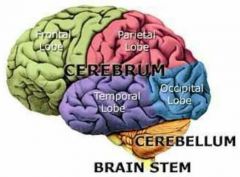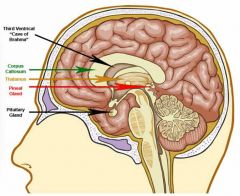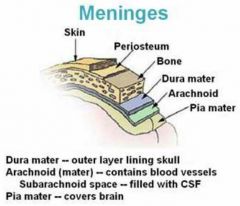![]()
![]()
![]()
Use LEFT and RIGHT arrow keys to navigate between flashcards;
Use UP and DOWN arrow keys to flip the card;
H to show hint;
A reads text to speech;
35 Cards in this Set
- Front
- Back
|
Consists of the brain and spinal cord: |
CNS |
|
|
Consists of 12 pairs of cranial nerves, and 31 pairs of spinal nerves: |
PNS |
|
|
Basic unit of the nervous system: |
Neuron (nerve fiber) |
|
|
The space between neurons are: |
Synapses |
|
|
Carry impulses from receptors to the CNS: |
Sensory neurons |
|
|
Carry impulses from the CNS to effectors: |
Motor neurons |
|
|
What are effectors: |
Muscles and glands |
|
|
Most peripheral neurons are myelinated by: |
Schwann cells |
|
|
CNS neurons are myelinated by: |
Oligodendrocytes |
|
|
____________ are entirely within the CNS. |
Interneurons |
|
|
A _____ is a group of neurons wrapped in connective tissue. |
Nerve |
|
|
Most peripheral nerves are _____ ______. |
Mixed nerves. |
|
|
Contains both sensory and motor neurons: |
Mixed nerves |
|
|
Largest part of the human brain: |

Cerebrum |
|
|
The four major parts of the brain are: |
-Cerebrum -Cerebellum -Diencephalon -Brainstem |
|
|
The __________, posterior to the brainstem, is concerned primarily with unconscious aspects of movement such as coordination, balance, and muscle tone. |

Cerebellum |
|
|
Between the cerebrum and brainstem, consists of the thalamus and hypothalamus: |
Diencephalon |
|
|
Main relay center for sensations (except smell): |
Thalamus |
|
|
Either of two masses of gray matter lying between the cerebral hemispheres on either side of the third ventricle, relaying sensory information and acting as a center for pain perception: |

Thalamus |
|
|
Controls body temperature, food and water intake, hunger and thirst: |

Hypothalamus |
|
|
The brainstem consists of: |
-Midbrain -Pons -Medulla oblongata |
|
|
Extends from the thalamus to the spinal cord: |
Brainstem |
|
|
The brainstem contains the ________ _________, which regulates the sleep-wake cycle: |
Reticular formation |
|
|
The ________ is the center for visual, auditory, and righting reflexes. |
Midbrain |
|
|
The _______ _________ contains centers the regulate the vital functions of heart rate, blood pressure, and respiration, and the reflexes for coughing, sneezing, and swallowing. |

Medulla oblongata |
|
|
The spinal cord extends from the medulla of the brain to the disc between the: |
First and second lumbar vertebrae |
|
|
The three meninges: |
-Dura mater -Arachnoid mater -Pia mater |
|
|
The outermost of the meninges, and the toughest, made of fibrosis connective tissue: |

Dura mater |
|
|
Made of weblike strands of connective tissue: |
Arachnoid membrane |
|
|
The innermost of the meninges, is very thin connective tissue on the surface of the brain and spinal cord: |
Pia mater |
|
|
Cerebrospinal fluid is found in the: |
Subarachnoid spaces |
|
|
The transmitter within the ganglia: |
Acetylcholine |
|
|
Most active during stressful situations and exercise: |
Sympathetic division |
|
|
Dominates during restful, nonstressful situations. |
Parasympathetic division |
|
|
Two subdivisions of the ANS: |
-Sympathetic -Parasympathetic |

